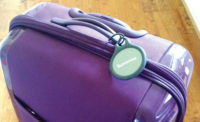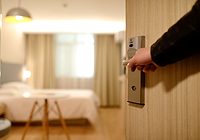In the consumerization of IT, such as the Bring Your Own Device movement, employees and stakeholders want their services delivered according to their preferences, and more and more are demanding digital, high-tech solutions.
RFID-based access control can build those consumer-friendly functions for enterprises while still streamlining the business for smoother operations and security.
“This technology is still somewhat new, but with upcoming proliferation,” says Fred Emery, Vice President OneCard Sales of Heartland Payment Systems’ Campus Solutions Division. Heartland provides solutions that support business and administrative processes across the entire life cycle of higher education, including card processing and payment managing for single-card ID and access solutions on campuses across the country, for financial transactions such as paying for printing, laundry, meals or other purchases.
“We’re working with tech-savvy clients, and we have to look to students’ expectations down the road,” Emery says.
At the Marriott/Fairfield Inn and Suites in Brooklyn, NY, the addition of RFID access control was a move for future-proofing the enterprise, as well as adding convenience for the customers. Previous magstripe-based access cards could become demagnetized by visitors’ cellphones, resulting in more visits to the front desk. This location also has a large percentage of international visitors, many of whom are used to touchless or RFID technology.
“Our customers are looking for safe and efficient technology they can understand,” says Marc Freud, Managing Principal of the Troutbrook Company, which developed and manages the Brooklyn hotel. “Hotels have a large amount of access points, and we needed better control and safety for employees and guests. We also wanted a more efficient front desk process.”
And the efficiency extends beyond the front desk, Freud adds – the new RFID readers increase accountability for staff, including food services, engineering, security, maintenance, general management and more, so management can better learn who had access to an area in the event of an incident.
“We promote a more widespread understanding of the system within the staff,” he says. “The staff knows and realizes what the benefits are, and we also let them know our new accountability standards through the system – all actionable events are recorded.”
The system extends to a customer service function well; the hotel – located merely five blocks from the Barclays Center – offers certain areas within the building as meeting or office space, specifically for technology startups. This Workspace on Demand area is designed as an incubator for tech companies at a minimal cost, aimed to attract more millennials to the hotel, however it also requires access control. Users can sign up for the space and register at the front desk for an access card. The RFID card can be programmed with time restrictions for the space, and it would be deactivated outside of that timeframe, allowing the hotel to provide a service without sacrificing accountability.
Managing incidents without auditing is a huge pitfall in access control, and outdated access management can lead to some embarrassing situations. According to Mike Petricca, Director of Campus Safety for the Academy of Art University in San Francisco, “We had 20 locations scattered across the city housing classrooms, offices and residential halls, each of which had multiple points of access and was protected only by basic locks and metal keys. Not only was this insecure, it didn’t give us an access control platform that would be easy to expand without forfeiting earlier investments. The inadequate security of our prior security arrangement became painfully apparent after a daylight break-in and burglary at the university’s Academic Building resulted in significant property losses. The thieves were captured, but it sent a message we needed to change our current practices, and we began the process of upgrading to a university wide card access system.”
In the same effort to improve security, the university migrated to an in-house campus safety organization that leveraged public safety best practices, resulting in a system that can be completely locked down with all access controlled through a single, centralized system – the first university in the U.S. to be able to do so, says Petricca.
The goal for the system was a balance between security and scalability, which required an access control system based on an open architecture that could support multiple card technologies and future enhancements.
“The university has realized a number of important benefits from our new access control system, including documented reductions in theft even as enrollment has increased, and an improved campus experience,” Petricca says. “The system has also significantly improved reporting capabilities, enabling the security team to, for instance, provide valuable input about building usage that resulted in new building access hours and policies. Also, with our new access control foundation in place, we can now embrace change and rely on this system infrastructure to support future improvements that will benefit faculty and staff, as well as students and their parents.”
Another enterprise-wide benefit of RFID is the option to add near-field communication, or NFC, capabilities moving forward. According to Freud, “Our ROI is probably going to occur in the near-future, based on the adaptability of the (RFID) lock, as in when the next-generation of access control, NFC, comes along.”
But in some organizations, NFC has already come along – Heartland Payment Systems’ office in Colorado Springs features a pilot program of NFC technology. Employees can use their NFC-enabled Android smartphones, or iPhones with a special case, to access the building, as well as for vending.
“On a corporate campus, it’s a convenience factor,” says Emery. “Initially, NFC is an enhancement to your RFID card, and later its use can lead to less loss of cards, faster reporting of loss and faster deactivation. Plus, the PIN code on smartphones is an additional layer of security.”
In terms of point of sale functions, such as vending or on-campus shopping, smartphones are often considered more efficient and easier than cards – smartphones are easier to grab and are not often left behind. Even in an office, employees would be more likely to take their smartphone with them to lunch or to a conference room than their access control card.
According to Emery, the use of NFC-enabled devices or multi-function RFID cards can lead to a “cashless” society on campus – a cohesive solution on one credential. Heartland has seen this switch lead to an increase in transactions, consolidation of financials, increases in impulse purchases, less possible theft (due to less cash), and more transaction process visibility, such as photo verification for meal purchases to reduce fraud.
“Overall, it turns into a service function. It makes the student’s life easier, and happier students will promote and stay at your institution,” Emery says.
At the Academy of Art University, a Knight Kash program complements the university experience – students can use their cards for dining on campus as well as at off-campus merchant partner establishments. The university also uses the cards for a part- and full-time employee payroll system, and Pettrica says that school officials are considering using the cards for student attendance systems and other future applications, as well as considering smartphone-based ID management.
He remarks, “At first there was a little reluctance in terms of the students’ and staff’s acceptance of the new system. Over time it has become second nature. Parents of our students love the fact that our doors are locked, and it gives them peace of mind. They realize we are committed to providing a safe and secure learning experience. Guests are never allowed on campus without written permission from a Department director.
“We also believe we are driving our students to be ID-centric which better prepares them for corporate life after graduation.”





